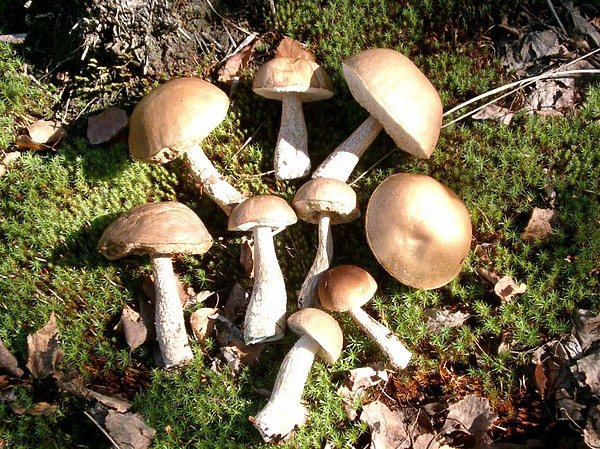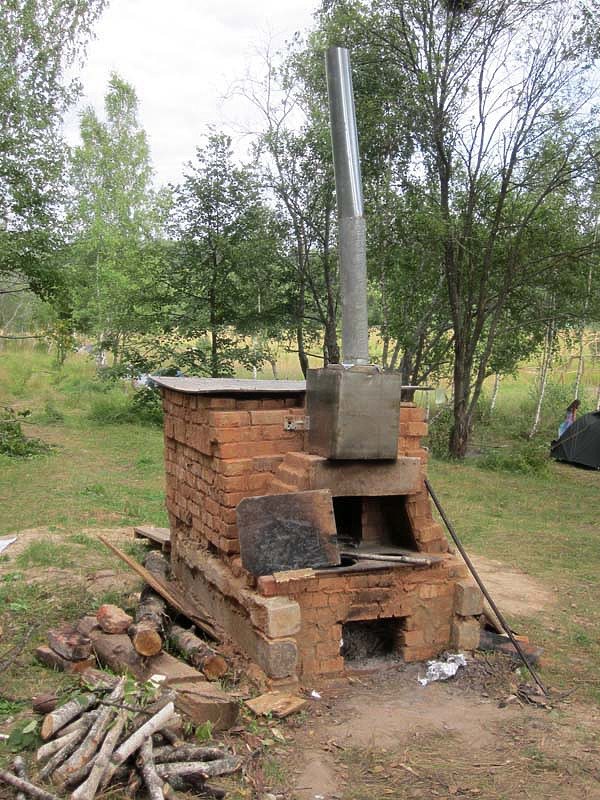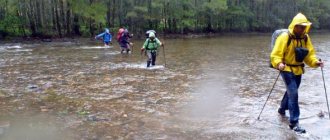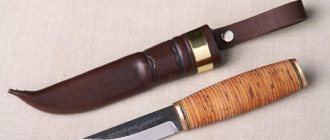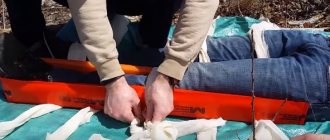True beauty is always hidden from the eyes. Therefore, sometimes you need to make a lot of effort to see real miracles and beauties that cannot be found below, in the bustle of cities. The best option for us to take a complete break from civilization is nothing more than an independent hike. This time we will tell you about our route to Yalta from Bakhchisarai. You will learn: how to prepare for a hike, plan a route, solve the issue of food, water, what things to take, what should be in the first aid kit, how to avoid a large crowd of tourists, and how not to get lost.
The hike begins with preparation and planning
Maybe someone doesn’t have time to study routes, maps and other educational material, but for us personally, this is where preparation for a hike begins. When it is still winter outside, but at the beginning of summer you are going to go hiking, there is nothing more pleasant than taking the time to create a new and unique route. Last year, we immediately decided on what we wanted to see on our hike. Our main points were the Grand Canyon of Crimea, Ai-Petri, suspension bridges to the battlements of Ai-Petri and the descent to Yalta, from where we continued on to the New World.
Decide what you definitely want to see on the route
How to plan your own hiking route
We planned to spend 3 days covering the walking route from the village of Sokolinnoye, near Bakhchisarai, to Yalta. The mileage we covered was about 37 km. Next, all that remained was to choose those paths on which there were more sources of fresh water, interesting natural attractions and suitable parking spots.
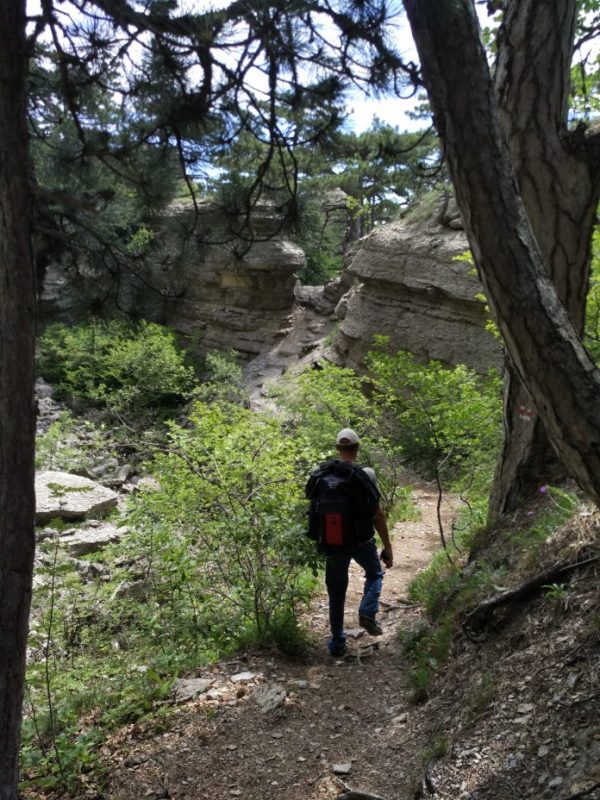
Use hiking trails in your route
Use hiking trails in your route
Having decided what you want to see, plan a route, calculate the mileage and divide the route segments by days. Then mark your overnight locations with flags. This will give you a picture of each day of your journey and what you will be able to see or do during your trip.
To create a route, I use the most convenient, in my opinion, OsmAnd map. This map shows parking areas, water sources, cliffs, attractions, observation decks from which the best views open, as well as elevation changes in order to assess the load and, in general, the possibility of overcoming a certain section of the road. In addition, you can connect route points on the map by linking them to walking or cycling trails, measure the distance between points and mark parking spots with flags.
Related article: How to create your own travel itinerary.

Get directions on the map
We take food, clothes and equipment - rules for packing a backpack on a hike
After we have calculated the mileage of our route and divided it into days, we proceed to the next stage - planning how much and what to take with us, and whether it is worth taking something at all, or it will turn out to be an extra load. What will be superfluous and what will not is up to you to decide. For example, we had a guitar with us on our hike, and not for the first time. Well, what can you do, if your friend’s last name is Agutina, then you are definitely doomed to sing. So the road is more fun and there is something to remember!
Decide what is important to you and go!
What will we learn?
Participants will have to master:
- Setting up a camp in difficult conditions
- Various methods of starting a fire: without matches using the “primitive” method, using a magnifying glass and in damp conditions on water
- Transferring fire from site to site
- Extracting birch tar to create a natural mosquito repellent
- Making pine tea and blueberry jam
- Construction of a camp bathhouse and washing during travel;
- Overnight without a tent - with the equipment of a warm bed
- Foraging for food in nature
- Manufacturing of emergency craft
- Making an overnight stay at altitude
- Techniques for long walks
- Opening canned food without a can opener and preserving the contents
- Skills in obtaining water and boiling water in a bag or plastic bottle
- Making an “Indian candle” or a tourist wood stove
- Making dishes from birch bark
- The use of herbs and plants in food, including medicinal ones
- Making a fishing rod and snare from improvised materials
- Night torch crossing
- Construction of crossings over streams and ravines
- Making a stretcher and transporting the victim
- Walking over rough terrain “in a team” of two for several hours in complete silence
- Orientation with the help of a map, compass - and also without them, using natural landmarks
Such a test will help each participant gain confidence in their abilities and take a fresh look at their capabilities, learn to better understand their reactions, the mechanism of how the body works and use the body’s hidden resources.
And also reveal yourself, learn how to learn to control yourself in a stressful situation, survive yourself and help others, and - become better, more confident and stronger!
Menu and cooking while camping
Since you want your backpack to be less drawn to the ground, and your food to be nutritious and have energy value, it’s worth using a few observations that once helped us.
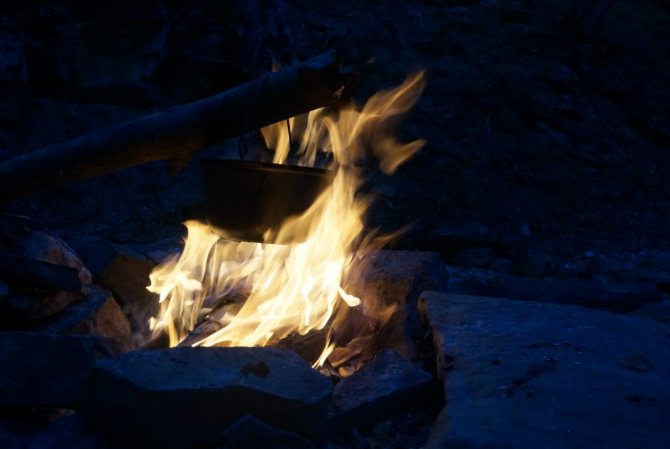
Cooking food over a fire
It is best to light a fire for cooking in the morning and evening, so as not to waste precious daytime time on the road preparing dinner. Our menu looks something like this:
- breakfast - porridge with dried fruits, nuts + sandwich and sweet tea or coffee, for example with condensed milk;
- lunch - sandwiches, canned food, with bread or pita bread + chocolate, raisins, nuts, dried bananas or other fruits;
- dinner - cereals, soups, sweets and drinks.
Article on the topic: Yoga tours: points of the earth where you can feel unity with nature
On our last hike, we decided to try buying freeze-dried camp food. Freeze-dried foods turned out to be an excellent option for fast, healthy and quite satisfying food. These are the same soups, porridges, potatoes with meat and other variety of dishes, only in dried form. Cooked food using this technology is completely dehydrated, crushed and dried. After which, when boiling water is added, it infuses for several minutes, becomes saturated with moisture and becomes suitable for consumption. Using this “camping food”, you don’t even have to take dishes with you. Thermal bags have a tight seal and are designed to steam food directly into them. Therefore, the only utensils you will need are a mug, a spoon, a fork and a small pot for the whole company to boil water.
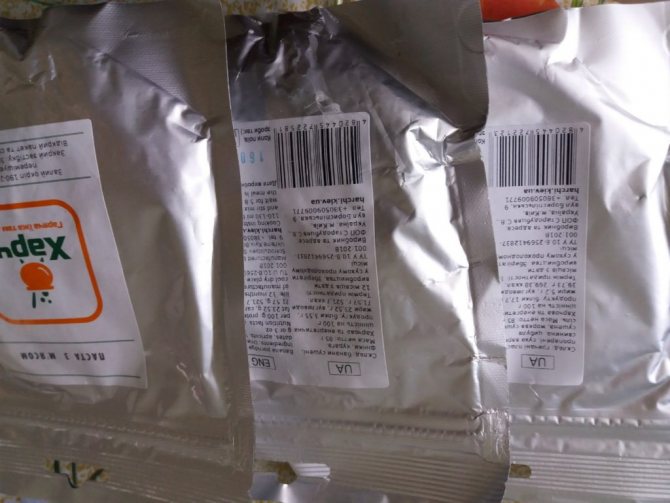
Freeze-dried foods - as one of the options for camping food
When choosing sublimates for a hike, pay attention to the number of kilocalories in each package of the selected dish. Because in some it can be about 200 kcal, and in others it can be more than 500 kcal.
Academy of Survival in Camping and Other Situations
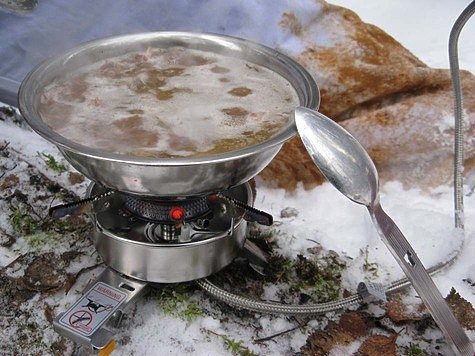
Naturally, there are no villages, no shops, or any human habitation nearby. It’s good if, when going on a hike, you have foreseen something and you have a knife, an ax, a flashlight, hooks and fishing line, and maybe even other fishing gear. In this case, it will be much easier for you than when you find yourself without all this in an unfamiliar place.
If you have some gear and you find a lake, river or other body of water nearby, then with a knife and suitable wood you can build a pretty decent fishing rod and catch fish for food. As bait, of course, anything that is at hand is suitable: worms, dragonflies, larvae, bugs, etc.
If you have neither hook nor line, then the situation is worse. But even in this case, there is often a way out. Try using a rope instead of a fishing line, and instead of a hook - a wire, a sharp twig, an accidental paper clip, etc. Here we can even talk about the use of some inhumane fishing methods, since in our case we are talking about human life.
In this case, a net, a prison, and other prohibited methods of fishing that are considered poaching are suitable. If you have boric acid in your medicine cabinet, you can use it: you can mix the drug in soaked bread crumb, make balls out of it and scatter it, and then collect the fish that floats to the surface with your hands. Most often it is a roach.
In general, if you find yourself in an unforeseen situation, in order to survive, you need to constantly experiment with ways of obtaining food and, even in difficult conditions, show a creative approach to business. Let me give you one example.
In 1978, I was part of a geological expedition in Kamchatka in the Sredinny Range region. After the radio failed, they could not find us for a long time. When the food ran out, we were forced to eat pasture. Since there was no gear, we made large hooks from thick steel wire, sharpened them sharply, and tied them to a pole like a hook. When red fish go to the upper reaches of rivers and streams to spawn, they periodically stop to rest behind cover, be it a boulder, a fallen tree or something else.
To catch a fish, you had to carefully bring the hook to it and, with a sharp movement, pick it up by the belly or behind the back, and quickly throw it ashore. In another case, fish were found in shallow oxbow lakes and impaled on a hunting knife tied to a pole. To prevent the fish from jumping off when taken out of the water, you first had to press the pinned fish to the ground and only then, holding it by the gills with your hand, throw it out of the water.
|
| photo: Semina Mikhail |
Recently, various kinds of extreme travel on kayaks, cars, floating and even flying vehicles have become popular. Hiking in the taiga, in the mountains, skiing in winter, and traveling for various tasks and purposes still remain popular.
Anyone going even just to a forest river to fish must be able to basicly navigate the terrain. You don't need a compass for this. It is enough to be able to navigate by the sun and natural features.
For example, as you know, an anthill is located from a tree, on the south side, moss on trees also grows mostly on the south side, snow in the spring lies longer on the northern slopes, in the mountains avalanches usually occur on the south side, etc. In addition, your observation and ability to think logically, as well as the ability to read tracks in the snow and on the ground, play a big role.
If you went on a trip by plane, helicopter or other aircraft and the approximate route of your flight is known to the relevant services, then in the event of an accident or emergency landing you need to be guided by the relevant rules and instructions, which are useful to study in advance, especially for those who are the first to travel once.
The basic rule: after an emergency landing in the taiga, mountains, or unknown terrain, the victims are prohibited from leaving the emergency landing site.
You should, without going anywhere, wait for help from rescuers or other search services. In fog, snowstorm and in case of bad weather, especially with limited visibility and short daylight hours, it is simply impossible to leave the scene of a disaster or emergency landing, even in accordance with elementary logic. It is obvious. In any case, if you find yourself in a difficult situation, you must not panic and make hasty, rash decisions, which could result in even greater disaster.
Below are ways to make primitive fishing gear from improvised materials and from the minimum supply of accessories that can easily fit in a small box and always have in your backpack.
Rod. The best fishing rods are made from young hazel shoots. To do this, you need to choose a straight whip 4-7 m long, clear it of knots and tie it to a straight pole or long board. In this position, you need to wait for the rod to dry.
|
| photo: Semina Mikhail |
Of course, in field conditions there is often no time to wait, and there are not enough available means. However, you shouldn’t be upset, since it’s quite possible to fish using a raw rod. Also, good fishing rods are made from shoots of juniper, rowan, maple and other trees. To make the tackle easier, you can remove a small section of bark, 1-2 meters, near the butt. The handle usually remains with the bark.
1. Some semblance of a jig can be made if the pellet located on the fishing line - the sinker - is moved close to the hook.
2. If the shank of the hook is elongated, then the lead pellet-sinker can be attached to the hook near the point of attachment to the fishing line.
3. A narrow piece of lead tape can be wound around the shank of the hook.
4. The simplest jig, made of a hook and wire. In this case, a simple hook and copper or aluminum wire with a diameter of 0.2-0.5 mm will help out. Carefully wind the annealed or “tempered” wire, turn by turn, onto a hook No. 2.5-5, depending on the desired size of the jig. The wire can be wound in one layer, then the jig will be in the shape of a worm, or you can wind the wire in two or more layers - then the jig will “get fat” and look more like a pupa or a fat caterpillar. When the fishing line is tied to the eye of the hook, the jig is in a vertical position.
5. If you manage to make a cut on gun shot or buckshot with a diameter of 4-6 mm with a needle file or a piece of hacksaw blade, then it can be used as a pellet sinker.
Fishing with a jig without a float is used both in the upper and lower layers of water for many fish, such as grayling, dace, roach, rudd, ide, chub, perch, trout and others. A flexible rod is used, cut from the shoots of hazel, maple, rowan or other wood.
For ease of casting, a fishing line with a jig attached to its end is tied along the length of the rod or slightly shorter. With a jig you can fish like fly fishing. In this case, the bait is held on top of the water, preventing it from drowning. During the current, the jig is pulled in the opposite direction to the current. Thus, it does not sink, but stays in the upper layers of the water.
In this case, various insects are used as bait. In the case of using a jig, casting the fly fishing tackle itself is significantly easier, because its weight significantly exceeds the weight of an insect or an artificial fly. It is effective to fish in the lower layers when the jig with the bait sinks smoothly or is carried away from a fast current into calm water.
Floats. Sufficiently good floats can be easily made from dry reeds, kugi, and the dry bark of some trees. The simplest fixation of a float on a thread or fishing line occurs through a double loop. If you can make a hole in the float using a wire or a nail, and then thread a fishing line into it and jam it with a match or a finely planed stick, then such fixation will be adjustable. If the float is made from a dry stick or twig, it can be fixed to the fishing line using a split (Fig. 2).
Donka. As a sinker for a primitive bottom, you can pick up some pebble on the shore. It is secured to the fishing line in a cross way, just like parcels are tied up. A smooth piece of a twig, into the split of which a fishing line is inserted, is suitable as a guard for the donkey (Fig. 3).
In addition, we did not mention that fish can be caught with your hands under stones, especially in strong currents, where not only burbot, but also bream, roach, silver bream and other fish find shelter.
Burbot, loaches and crayfish are caught by hand in coastal burrows.
Loaches are collected by hand, stirring up the water in a muddy river basin. Eels crawl on dry land when the grass is wet from dew or rain.
|
| photo: Semina Mikhail |
On narrow, low-flowing reservoirs, you can make fence fences and install baskets woven from flexible willow rods or other coastal trees - ventera. In this case, the fish, accustomed to migrating, will look for a way to pass through the fence and enter the hole in the basket.
In winter conditions, ice traps are set up to catch fish in the ice. There are many ways to make them. For example, in a place where fish accumulate, you can make two ice holes, in one of which a basket or bag for fish is installed. The ice holes are connected by a shallow trench 1.5-2.5 m long.
A primitive paddle is made from wood to fit the width of the trench. This oar is used to push water from one ice hole to another. The current will grab the fish and pull it into the hole. Another trap option is a wide and deep trough with a hole in one of the corners. Such a trap can be effective where fish accumulate near the shore at a depth of only a few centimeters.
In addition, you can throw fish onto the ice when it is trapped at a very shallow depth by rocking the ice floe, but this is very dangerous, since if you move carelessly, it is not surprising to fall into the water or, worse, be squeezed into a crack.
Once again, let us make a reservation that all this is written only for those who find themselves in extreme conditions, and there is a struggle for survival; the rest of the time, the use of traps and other illegal methods is poaching. However, it must be remembered that even when fishing with sport gear under normal conditions, excessive catching of fish that will not be used for food is also considered poaching.
Alexey Goryainov November 27, 2020 at 02:20 pm
Where to replenish water supplies on a hike and how to purify it
Water on the road is vital and priceless. Near each source you encounter, you need to refresh the contents of the bottles, even if you haven’t had time to drink all the water. In addition, you can purify the water or kill harmful bacteria in it, especially if the source or well does not seem very clean or there is stagnant water.
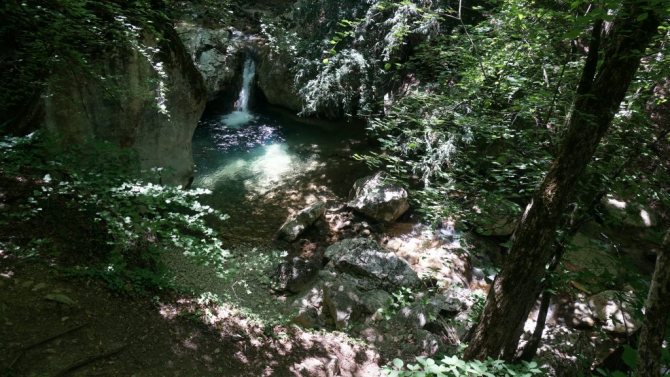
Don’t pass by sources of clean water – renew your supplies
For this you will need antibacterial tablets, such as Aqua Breeze, Aquachlor, Pantocid or their analogues. Each of them has its own instructions for use, but the principle of operation is the same for all. You just need to throw the tablet into the water and wait about 40 minutes before the water becomes suitable for drinking raw.
Camping survival
Self-sufficient survival while hiking is attracting more and more people. Indeed, civilization in our time “strangles” a person, turning him into an appendage to gadgets, so survival in the wild becomes a kind of counterculture, attracting everyone who wants to be a bright individual. But you should understand that real survival is not toys. You can seriously undermine your health, or even lose your life.
Hiking and survival
To begin with, you should learn the simplest basics of survival: making a fire in dry and windless weather, orienteering, the ability to set up an overnight shelter and find water suitable for drinking. All this can be learned from videos from the Internet, literature or advice on forums. If you don't start your survivalist career during the cold season, then you don't risk anything. It is best to take such lessons in a suburban area; it is not worth going to the taiga for this.
Then you can move on to more complex survival lessons: learning to make a fire in rain and snow, making water filters and setting up a hut that can protect you from the chilly wind and rain. Here you can already use elements of bushcraft - making objects using scrap materials. It is also advisable to study the properties of herbs, methods of catching game and much more. Only after this can you go on a hike with elements of survival for several days.
A hike with elements of survival should be planned in advance, carefully considering the route and possible evacuation methods. Be sure to tell the Ministry of Emergency Situations and several relatives or friends where you are going. For the first time, it is best to choose regions that are easy to navigate and reach people. So, a survival trek through the Crimea would be a wiser decision than a trek through the taiga.
The most important thing in a hike with elements of survival is to correctly correlate your capabilities and tasks. If you know about something, but do not have practical skills, consider that this knowledge is useless. Only practice can make you an experienced survivalist. The amount of equipment purchased and content read (or watched) will not help here.
Finally, I would like to say: take care of yourself! It happens that people go into the taiga out of great need and lose their bearings along with the ability to get out. Remember that the science of survival is unlikely to help you if you do not survive the process of mastering it.
Clothes and shoes for hiking
Clothes for a hike should be natural and practical. If you are going to go in the rainy season, take care of a change of clothes and shoes. If rain is not expected, still take raincoats and covers for your backpacks. Even in summer, clothing should be closed, that is, long pants and sleeves. I like to bring a few changes of t-shirts and a natural long sleeve shirt when hiking. Thus, the body remains protected from the sun, scratches and insect bites.
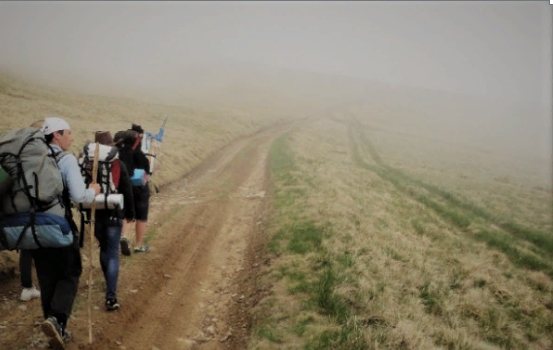
Use closed clothing in any season
To avoid sunstroke or frostbite, avoid synthetic clothing. The body sweats in it and feels like being under plastic. It’s good when there is a natural undershirt or T-shirt under outerwear, this creates an air layer and the skin can breathe freely in a normalized environment.
Shoes should be closed, but breathable, and the soles should be grooved. This way you can stay on your feet more confidently, on any surface: slippery grass, smooth stones or wet ground.
Essential camping gear
Your equipment will also vary depending on the time of year. It is advisable to take care of having a good backpack, tent, sleeping bag and mat. Modern backpacks are equipped with an adjustment system that allows you to adjust its elements according to your height and build. In addition, make sure that the backpack has a hard back, this will distribute the weight of the load over the entire back, and not just on the shoulders or lower back.
Advice! When completing a backpack, do not place a heavy load in its lower part, but try to distribute all the weight throughout the entire height of the backrest.
In this way, you will prevent improper loads and subsequent pain in different parts of the spine. If possible, the tent should be waterproof and have two layers. The latter condition allows you to prevent the accumulation of condensation and maintain a constant air exchange process. Check the temperature of the sleeping bag; they can be designed for winter or summer, as well as for the off-season. Cocoon sleeping bags weigh less and take up less space than blanket sleeping bags. But I personally have the last option, which completely suits me.
Article on the topic: Comfortable holiday in Crimea. Where to go.
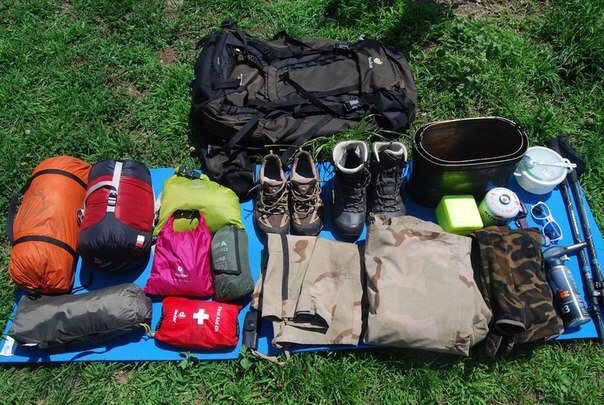
If you choose a sleeping bag, then if possible, do not take options made of synthetic materials. Make sure that both inside and outside it is sewn from natural fabric. In cool weather, it may seem that synthetics are fully performing their functions, but this is not the case. In summer, such a sleeping bag will float and create significant discomfort.
Some people decide to use a gas burner while camping, but we use the old simple method - we make a fire. There have never been any difficulties with a lack of firewood or the inability to light a fire. But given the specifics of the route you choose, consider both options.
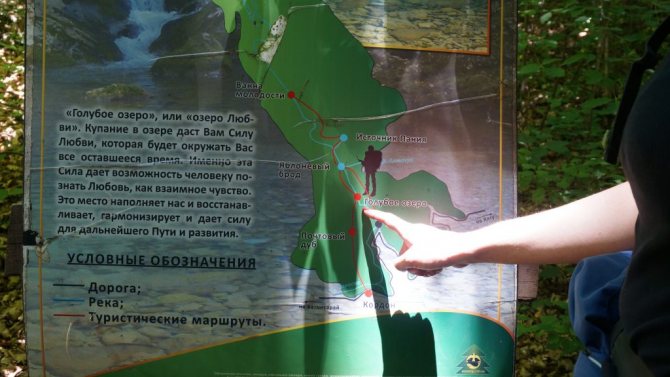
You need to follow the signs along the route
Try to find designated parking areas along the route. There are always places for fires there for the same “green” travelers. This will allow you to set up your camp in a more comfortable place, contribute to the safety and security of the forest and maintain cleanliness.
Tips from experienced survivalists: A dugout for survival in the forest far from civilization
This does not apply to wild plants. • Never throw pieces of paper or any small items in the forest, and especially do not make notes (marked places) with scraps of rags, thereby giving yourself away.
Mark places in another, less noticeable way, for example, knock down a thin tree with its roots, or break it in the middle.
Use “eternal” signs, even those that are nearby. Using them you can always find what you buried or noticed.
• Try not to follow the same routes (trail after trail), walk in the same place, but nearby, DO NOT trodden paths, trodden paths and even far from home, you give the enemy a chance to stumble upon such a path, to understand that it is not an animal one, and bring him straight to you. This does not apply to swamps. In the swamps everything is different.
• When cutting mushrooms, ALWAYS cover the cut stem with a piece of moss; cuts of porcini mushrooms and boletus mushrooms are visible after your “hunt” for another 3-4 DAYS, depending on the temperature.
• When cutting down trees for firewood, ALWAYS cover the top of the stumps with moss, and cut as close to the ground as possible so that they do not stick out. A white cut of a tree can be seen from the air from a great distance for about a YEAR. And never cut down trees nearby, several at a time, when doing such mini-cutting, you find yourself from the air. Cut down 1-2 trees, in different places.
If dry wood has never been cut down in the forests, then there is a lot of it there, and in principle it never ends.
*Try not to catch birds on lakes; a flock of ducks rising sharply indicates that someone has swam up to them, and this is clearly not a fox or a wolf. Suspicious. Large flocks hide on lakes, small ones and pairs hide in rivers; when a large flock takes off, it means something has greatly frightened it.
• If you dumped in a car, then upon arrival at the place, camouflage the car very well, but so that you can quickly jump into it and dump again if something happens. You don’t need to drive 100 meters to get firewood, it’s better to drag it like that. The sound of the engine running in a quiet forest can be heard up to 2 km.
• If you come across game or an animal, do not cut up or pluck the bird on the spot, take it home and freshen the carcass there. Feathers, pieces of meat, skin, etc. thrown at a distance from the house reduce your exclusion zone and bring searchers closer to you.
And besides, I would collect feathers, the skin would also come in handy. And the head of a black grouse, for example, is an excellent bait for traps.
• Try not to light fires anywhere; by the remaining heat and coals, search engines can tell exactly when it was burned.
• Well, you should have a camouflage suit.
